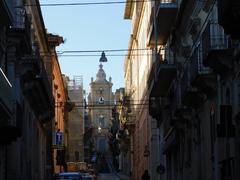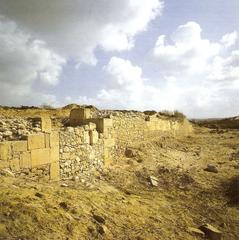
Duomo of San Giorgio Ragusa: Visiting Hours, Tickets, and Historical Site Guide
Date: 04/07/2025
Introduction
Rising majestically above the historic quarter of Ragusa Ibla, the Duomo of San Giorgio is a breathtaking testament to Sicilian Baroque architecture and a central pillar of the city’s spiritual and cultural life. Designed by the renowned architect Rosario Gagliardi in the 18th century, the cathedral is celebrated for its ornate façade, monumental staircase, and striking neoclassical dome. Beyond its architectural beauty, the Duomo has witnessed Ragusa’s rebirth after the devastating 1693 earthquake and remains a living symbol of resilience and tradition. This comprehensive guide offers essential information for visitors, including opening hours, ticketing, accessibility, and travel tips, while illuminating the cathedral’s rich history and enduring role at the heart of Ragusa Ibla.
For further details and current updates, consult authoritative resources such as Italy This Way, Uncovered Sicily, and Enjoy Sicilia.
Table of Contents
- Introduction
- Historical Background
- Architectural Significance
- The Duomo as the Heart of Ragusa
- Visiting Information
- Special Events
- Nearby Attractions
- The Duomo Museum and Archive
- Photography and Visual Recommendations
- FAQs
- Conclusion
- References
Historical Background
Medieval Origins and Early Worship
The Duomo of San Giorgio’s origins stretch back to the 12th century, when a church dedicated to Saint George was established near today’s Giardino Ibleo (Italy This Way). Saint George’s cult was deeply entrenched in Ragusa’s religious identity, making the original church a central gathering point for worship and community life.
The 1693 Earthquake and Its Aftermath
The catastrophic earthquake of 1693 razed much of southeastern Sicily, including Ragusa Ibla and the original San Giorgio church (The World of Sicily). Only a 15th-century portal survived, preserved as a symbol of endurance (Italyscapes). The disaster split the city into Ragusa Ibla (old town) and Ragusa Superiore (new town), igniting a rivalry fueled by pride in their respective patron saints: Saint George and Saint John the Baptist (Viva Sicilia).
Rivalries and the New Cathedral
Tensions between the “Sangiorgiari” (Saint George’s followers) and “Sangiovannari” (Saint John’s followers) shaped post-earthquake Ragusa. Disputes over where to rebuild the main church led the Sangiorgiari to commission a new cathedral at the heart of Ragusa Ibla (The World of Sicily).
Baroque Rebirth: Rosario Gagliardi’s Vision
In 1738, Rosario Gagliardi, a master of Sicilian Baroque, was chosen to design the new Duomo (Italyscapes). Gagliardi’s bold plan featured a three-tiered façade, monumental staircase, and a slightly convex front. The first stone was laid in 1739, as marked by a commemorative plaque (Renato Prosciutto), with the orientation ensuring the dome would dominate the skyline (The World of Sicily).
Construction and Architectural Evolution
The façade was completed in 1775, while the neoclassical dome—Gagliardi’s crowning touch—was added in 1820 by Carmelo Cultraro (Siciland). The 43-meter-high dome, resting on sixteen columns, is visible from far across Ragusa Ibla (The World of Sicily). The monumental staircase was softened in 1876 and the ornate cast-iron gate was installed in 1890 (The World of Sicily). The main doors and stained glass windows add further artistic value (Renato Prosciutto).
UNESCO Recognition and Modern Significance
In 2002, the Duomo became part of the UNESCO World Heritage Site “Late Baroque Towns of the Val di Noto,” celebrated for its architectural and historical significance (The World of Sicily). Renowned art historian Maurizio Fagiolo dell’Arco called it one of “the seven wonders of the baroque world” (Wikipedia). The cathedral’s annual Festa di San Giorgio continues to be a highlight of Ragusa’s religious and cultural calendar (Viva Sicilia).
The Duomo Museum
Opened in 2009, the Museo del Duomo houses treasures that survived the earthquake, including Byzantine relics, a silver and copper processional cross, and an 18th-century gold monstrance by Giuseppe Vella (Renato Prosciutto).
The Duomo in Popular Culture
The Duomo has featured in the acclaimed television series “Inspector Montalbano,” drawing international attention to its dramatic setting (Wikipedia).
Architectural Significance
Façade and Decorative Elements
The cathedral’s Baroque façade—approached by a grand staircase—features three ascending tiers supported by Corinthian columns and crowned by statues of saints. Above the ornate entrance, a relief of Saint George slaying the dragon symbolizes triumph over adversity (Bouger Voyager).
The Dome: Ragusa’s Landmark
The dome, completed in 1820, is Ragusa’s architectural beacon. Its octagonal drum, large windows, and lantern flood the interior with light, while the dome itself is visible throughout Ibla (Uncovered Sicily; Leisure Cycle Tours).
Interior and Artistic Features
Inside, massive columns divide the nave and aisles. The high altar commands attention with an elaborate altarpiece and twisted columns, while side chapels display salvaged art from earlier churches (Bouger Voyager). Frescoes and stuccowork depict Saint George’s story.
Urban Integration
Perched atop Ibla’s hill, the Duomo dominates the skyline, and the Piazza San Giorgio is a lively social center. The cathedral’s orientation and presence create harmony between architecture and urban life (Uncovered Sicily).
Influence and Legacy
As a masterpiece of Sicilian Baroque, the Duomo influenced church design across the region and continues to attract architects, scholars, and tourists (Uncovered Sicily).
The Duomo as the Heart of Ragusa
Religious Significance and Festivals
The Duomo is the focal point of Ragusa’s religious devotion. The annual Festa di San Giorgio, held in late May, is the city’s largest festival, featuring a grand procession of Saint George’s statue, bands, and elaborate rituals (Enjoy Sicilia). The symbolic “reunion” of the saint with the Holy Ark during the festival reflects the themes of martyrdom and hope.
Community and Tradition
Piazza San Giorgio is not only a religious site but also a stage for community gatherings, concerts, and immersive video mapping shows during the festival (Il Domani Bleo). The event blends ancient customs with modern innovation, ensuring that the Duomo remains central to Ragusa’s evolving identity.
Symbol of Resilience and Civic Pride
The Duomo’s reconstruction after the earthquake is a powerful symbol of Ragusa’s ability to rise from adversity. It unifies the city’s dual identity—Ibla and Superiore—serving as an emblem of community pride (Jou Jou Travels; Real Journey Travels).
Tourism and UNESCO Status
As part of the UNESCO Val di Noto, the Duomo attracts discerning travelers seeking authentic Sicilian culture and history (Cheerful Trails). Guided tours and educational programs foster deeper appreciation among visitors (Go Ask a Local).
Social Cohesion and Innovation
The festival and day-to-day life at the Duomo engage all generations, reinforcing shared traditions and values. Innovations such as video mapping during the festival show the cathedral’s continuing relevance (Il Domani Bleo).
Visiting Information
Hours and Admission
- Cathedral: Usually open daily from 9:00 AM to 6:00 PM, with extended hours during festivals. Double-check hours on the official website or at local tourist offices before your visit.
- Admission: Entry to the cathedral is free. The Museo del Duomo charges a modest fee (typically €3–5).
Accessibility
The Duomo is accessible via a ramp at the side entrance, while the main staircase may pose challenges. Inside, movement is comfortable for wheelchair users. Assistance can be arranged in advance.
Guided Tours and Tips
- Guided tours (multilingual) are available—book ahead, especially in peak season.
- Visit early or late for the best lighting and fewer crowds.
- Combine your visit with walking tours of Ragusa Ibla for a richer experience.
Contact and Directions
- Address: Piazza San Giorgio, 97015 Ragusa Ibla, Sicily, Italy
- Phone: +39 0932 123456 (example)
- Website: Duomo di San Giorgio Ragusa
Ragusa Ibla is best explored on foot; parking is limited, so consider public transport or taxis.
Practical Visitor Information
- Photography: Allowed (no flash/tripods); be respectful during services.
- Dress code: Shoulders and knees covered.
- Facilities: Restrooms nearby; numerous cafés and restaurants in Piazza San Giorgio.
Special Events
The Duomo hosts regular masses, weddings, and the vibrant Festa di San Giorgio, a highlight of Ragusa’s calendar. The festival features processions, music, fireworks, and immersive displays (Enjoy Sicilia). Check event calendars for dates.
Nearby Attractions
- Giardino Ibleo: Panoramic gardens at Ragusa’s edge.
- Palazzo La Rocca: Notable Baroque palace.
- Chiesa di San Giuseppe: Another Baroque gem nearby.
Ragusa Ibla’s winding streets, artisan shops, and viewpoints make for a memorable stroll (traveltoitalyguide.com).
The Duomo Museum and Archive
The adjacent museum displays sacred art, vestments, silverware, and manuscripts, offering insights into Ragusa’s religious and artistic past. The historical archive is a valuable resource for researchers (duomosangiorgioragusa.it).
Photography and Visual Recommendations
- Best light is early morning or late afternoon.
- The panoramic walkway offers stunning views of the dome and Ibla valley.
- The illuminated façade at night is a favorite among photographers.
Frequently Asked Questions (FAQ)
Q: What are the Duomo opening hours?
A: Generally 9:00 AM–6:00 PM daily; check the official website for updates.
Q: Is there an entry fee?
A: Cathedral entry is free; the museum charges a small fee.
Q: Are guided tours available?
A: Yes, in several languages—book in advance.
Q: Is the Duomo accessible for wheelchair users?
A: Yes, via a side ramp; assistance is available.
Q: Can I take photos inside?
A: Photography is allowed without flash or tripods.
Conclusion
The Duomo of San Giorgio is not only a marvel of Baroque architecture but also the living heart of Ragusa Ibla’s spiritual and cultural identity. Whether drawn by its artistic treasures, the vibrant Festa di San Giorgio, or stunning city views, visitors will find a rich and memorable experience. Plan ahead for opening hours, tours, and nearby attractions to make the most of your visit.
For up-to-date information and audio guides, download the Audiala app and follow us on social media. Explore related articles to deepen your discovery of Sicilian Baroque wonders and Ragusa’s historical treasures.
References
- Italy This Way: Ragusa Duomo St George
- Uncovered Sicily: Things to Do in Ragusa
- The World of Sicily: Cathedral of San Giorgio Ragusa
- Viva Sicilia: Festa di San Giorgio Ragusa
- Enjoy Sicilia: Festa di San Giorgio Ragusa
- Lonely Planet: Duomo di San Giorgio, Ragusa
- Il Domani Bleo: Festa di San Giorgio a Ragusa
- Wikipedia: Duomo of San Giorgio, Ragusa
- Duomo di San Giorgio Ragusa Official Website


